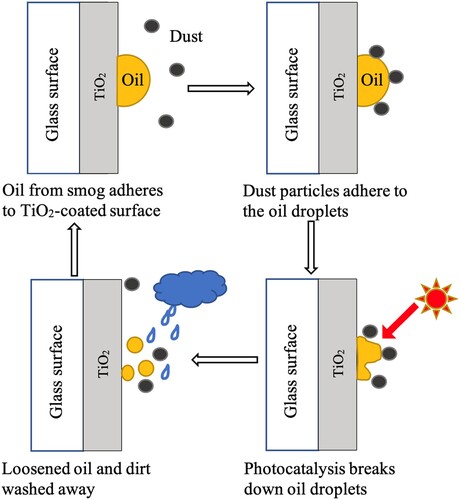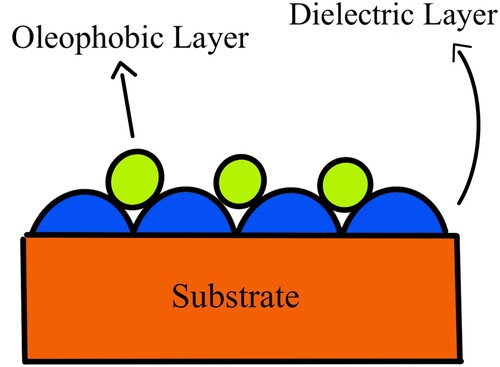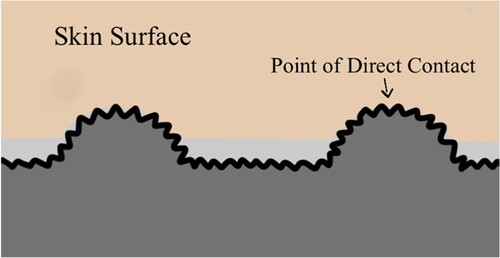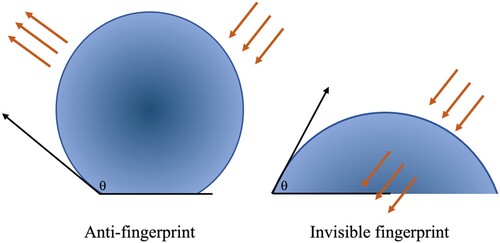The advent of numerous types of smart phones and engineering devices with touch screens has necessitated the need for protective coatings that do not leave fingerprints on the surface. As applications evolve in transportation and security, the use of biometrics is becoming increasing popular causing more challenges to be faced in proper identification in a timely manner. For individuals, it is important that they are protected from misuse of the fingerprints left on surfaces to impersonate or alternatively misuse applications that require privacy.
Glass is the predominantly used surface for most applications. There are few, if any, applications of glass that do not require specific surface characteristics for functional and/or aesthetic purposes. Chemical and physical surface modification treatments on glass are used to produce controlled special variations of their optical, electrical, chemical and mechanical properties. With the proliferation of devices with touch-based operations, an important functional surface characteristic required of glass is now smudge/fingerprint resistance coupled with maximum security.
The concept of smudge-proof glass predates development of touch devices, and has been known for many decades as self-cleaning glass. The earliest commercial self-cleaning glasses such as Pilkington Activ, SunClean brand, Neat Glasses and SGG Aquaclean had nanometric coating of titanium oxide that breaks down dirt and grime through photocatalysis and hydrophilicity (). These continue to be used in windows and other such architectural applications for aesthetics.
Besides touch devices, the use of eyeglasses and high precision and clear lenses for both biomedical and research purposes, anti-fingerprint (AF) treatments provide aesthetic appeal and functional treatments are constantly being evaluated for their efficiency coupled with ease of application and cost.
Fingerprint is a layer of oil(sebum)-based and water(sweat)-based contamination that remains on a surface after a finger has touched it, AF treatments must render glass resistant and be omniphobic resisting both water and oil transfer. Fingerprint liquids have lower surface tension (20–50 mN m–1) than water and this results in an easy adhesion on the touch surface. Thus, AF treatments have involved chemical or physical modifications to the glass surface to reduce its wettability by both oil and water, in-effect, conferring omniphobicity (hydro- and oleo-phobicity) to it.
Surface energy and topography of surfaces decide their fingerprint resistance characteristics. The synergy between the two factors results in air being trapped in the surface pores under the liquid, which results in omniphobicity. However, the challenge is to modify surface energy and topology of surfaces without altering the functional properties, such as transmittance, reflection, mechanical durability and chemical stability of the underlying substrate [Citation1].
Of the chemical methods of glass surface modification, organosilane-based coatings remain the most widely researched and developed for AF purposes. Silanes react with glass through the formation of siloxane (Si–O–Si) bonds and therefore have good adhesive strength. While silane or siloxane polymers are known to be water-repellent, even superhydrophobic, the excess of C-H bonds in the pendant groups confer oleophilicity, which are usually overcome through the introduction of carbon-fluorine (C-F) bonds in the matrix [Citation2]. The high electronegativity of the fluorine atoms in the C-F bond has been shown to result in oleic contact angles greater than 60° [Citation3]. AF coatings produced for lenses and touch devices by the pioneering Japanese chemical manufacturer, Daikin, are based on perfluoropolyether (PFPE) silane. These oleophobic polymers are applied to nanometric thicknesses on the glass surface using a spray or PVD process. PFPEs are non-crystalline fluid polymers that prevent oil from sticking to the coating.
Fluorinated coatings have poor adhesion to glass because of their low surface energy. Some methods to overcome this problem have been the use of bifunctional particles that possess surface-fluorinated and hydroxyl groups. The former affords omniphobicity while the latter bonds with epoxy or polyurethane glues that can be applied to the glass substrate ().
Figure 2. The action of Daikin’s PFPE-based Optool coating as compared to other forms of surface treatment. Optool prevents sebum and moisture from sticking on to the glass from the skin. Image reproduced from [Citation4] without modification.
![Figure 2. The action of Daikin’s PFPE-based Optool coating as compared to other forms of surface treatment. Optool prevents sebum and moisture from sticking on to the glass from the skin. Image reproduced from [Citation4] without modification.](/cms/asset/ed19a0a6-20d2-4e94-8116-29f65068cfc8/ysue_a_2131043_f0002_oc.jpg)
There have been reports of photocurable coating formulations comprising fluoropropionic acid-modified Polyhedral oligomeric silsesquioxane (POSS) ().
Figure 3. Transparent omniphobic GPOSS coatings modified with perfluorinated agents. Image reproduced from [Citation5] without modification.
![Figure 3. Transparent omniphobic GPOSS coatings modified with perfluorinated agents. Image reproduced from [Citation5] without modification.](/cms/asset/d48f3057-2118-40ca-9b63-57a5d5ca81c0/ysue_a_2131043_f0003_oc.jpg)
In industry, oleophobic and/or omniphobic coatings are typically applied to glass through vacuum and/or vapour deposition processes. An energy source, such as an electron beam, vaporizes dielectric materials that are vacuum sealed to the outer layer of the glass. After the required thickness of dielectric materials is obtained, the oleophobic evaporative materials are deposited on the surface, to form a permanent chemical bond with the underlying dielectric material. These layers are extremely thin monolayers that offer negligible resistance to light, thereby enabling maintenance of transparency ().
Today, there is ongoing research in both academia and industry to develop better AF formulations, preferably without fluorine. Solution-based deposition processes [Citation6] and sol-gel [Citation7] methods are being explored for ease of applications concurrent with reduced costs. There has also been active interest in the development of organic-inorganic hybrid coatings by sol-gel processes because of high substrate adhesion and possibility of functionalization. Epoxy-siloxane-based copolymeric systems, for example, combine the mechanical flexibility of the epoxy moiety and the elastic resilience and wear-resistance of the siloxane.
Fingerprint resistance has also been enabled through improvements in abrasion resistance of the surface through incorporation of nano-dimensional fillers such as titania [Citation8] or silica [Citation9] nanoparticles into the organic or organo-inorganic matrix. In many cases, since the organic polymer matrix is not compatible to the high-temperature calcination processes required for the inorganic fillers use of high-temperature calcination processes, the oxides are first deposited followed by the organic film, or low-temperature processes such as pulsed laser deposition are used [Citation10].
While the physical surface modification of glass has been extensively studied to confer hydrophobicity to it, its use in AF applications has been less actively explored. Surface microstructures created by etching or laser processing can produce surface micro-irregularities that can confer omniphobic characteristics. However, such studies are rarer; there have been sporadic reports of the use of methods like microslurry-jet [Citation11] and anisotropic etching [Citation12] to confer fingerprint resistance to glass ().
A new approach to AF treatment is not to prevent fingerprint but to hide it. The phenomenon, now called ‘invisible fingerprint’ (IF) is enabled through the use of oleophilic rather than oleophobic coating on glass. Due to the oleophilicity, oils from the fingerprint spread along the surface rather than remaining at one place, thereby forming a sub-nanometric film through which light can pass uninterrupted at most angles. This creates the optical illusion of the smudge not being present at all. This is in contrast to oleophobic coatings that make the oil residues bead up on the surface and run out ().
IF coatings are made of silane polymers that are oleophilic and hydrophobic, the former property spreading the oil contaminant and the latter allowing for easy cleaning. NPD Nano has commercialized the first IF coating – InvisiPrint® – that is organosilane-based and applied to glass surfaces by atomized spray to thicknesses of 10–20 nm. Advertised as being fluorine-free, this product has a water contact angle of 85° and a Diiodomethane contact angle of 35°and has been reported to show a 800% improvement over traditional anti-fingerprint coatings.
There have been a few patents on IF coatings showing that this technology has significant commercial potential [Citation13]. Most of these patents report the use of organo-inorganic nanohybrids such as hydroxyl-polyhedral oligomeric silsesquioxane ().
Figure 7. A patent for IF coating formulation comprising hydroxyl-polyhedral oligomeric silsequioxane. Molecular structure from [Citation13].
![Figure 7. A patent for IF coating formulation comprising hydroxyl-polyhedral oligomeric silsequioxane. Molecular structure from [Citation13].](/cms/asset/341e513f-b88e-474b-9dfe-06ddc4477c90/ysue_a_2131043_f0007_ob.jpg)
A 2017 paper from MIT reported dactylovorous (‘fingerprint eating’, from the word ‘dactylogram’ that means fingerprint) coatings based on titanium dioxide nanoparticles, which are superoleophilic, transparent and rapidly decompose fingerprint oils under UV light [Citation14]. The mechanism was described as the wicking of the sebum into the nanoporous titania structure followed by photocatalytic degradation ().
Figure 8. ‘Fingerprint Eating’ coating reported at MIT. Image reproduced from [Citation14] without modification.
![Figure 8. ‘Fingerprint Eating’ coating reported at MIT. Image reproduced from [Citation14] without modification.](/cms/asset/7ee42c20-d3fe-4f11-ab60-3f12a26ae36c/ysue_a_2131043_f0008_oc.jpg)
An interesting recent research conducted jointly by Southeast University, China and Max Planck Institute, Germany reported a heterogeneously wetted glass made of nanopillars with oleophilic top surfaces and oleophobic sidewalls and bases [Citation15]. The contrast wettability was shown to break the fingerprint oils into fragmented films, which resulted in a 74.5% increase in fingerprint resistance and 59% improvement in fingerprint removal efficiency over conventional oleophobic glass ().
Figure 9. Heterogeneously wetted glass made of nanopillars with oleophilic top surfaces and oleophobic sidewalls and bases. Image reproduced from [Citation15] without modification.
![Figure 9. Heterogeneously wetted glass made of nanopillars with oleophilic top surfaces and oleophobic sidewalls and bases. Image reproduced from [Citation15] without modification.](/cms/asset/7e82dc79-414d-48cb-8000-22de6f5227fa/ysue_a_2131043_f0009_oc.jpg)
The market for AF coatings is driven by the surging use of touch devices, healthcare equipment, optical displays, automobile parts and solar energy panels that require clear smudge-proof surfaces. According to Emergen Research, the global market for AF coatings, irrespective of substrate was 779.9 million in 2019 and is expected to reach to reach USD 1.2 billion by 2027 [Citation16]. In terms of Display Glass Anti-Fingerprint Coatings, Exactitude Consultancy expects the global market to exceed USD 469 million by 2026 [Citation17]. In terms of application, electronic products have been the leading segment requiring AF treatment on glass.
Much of the current market focuses on oleophobic coatings, with only recent interest in oleophilic coatings. Current makers of commercial Display Glass Anti-Fingerprint Coatings include Daikin Industries, Amazfit, PPG, Schott, 3M, Dow Inc, NBD Nanotechnologies, Solvay, AGC Chemicals, Aculon, Shin-Etsu Chemical, Dynasil, SDC Technologies and Cytonix.
A few challenges and opportunities remain in the development and commercialization of AF and IF coatings.
Oil-repellence and transparency are conflicting conditions, and it is difficult to design materials that have both properties.
Most of the commercial transparent, omniphobic coatings contain fluorine, and fluorinated polymers are associated with environmental and health issues and are generally not preferred.
Non-fluorinated coatings must be compatible with existing coating methods used for glass, and comparable in performance, especially with relationship to omniphobicity.
Durability of the coatings continues to be a significant issue. The water contact angles of commercially available AF coatings reduce by approximately 20–30° after 1500 cycles of pencil eraser abrasion.
While oleophobic and oleophilic coatings can help combat the formation and visibility of fingerprints, respectively, they cannot completely eliminate them, especially on high gloss displays because of the disparate refractive indices of oil and the display glass.
Materials research often ignores the manufacturing issues. There are set methods used in glass fabrication for specific applications, and the application of the AF solution must be conducive to being incorporated in existing methods.
References
- Belhadjamor M, el Mansori M, Belghith S, et al. Anti-fingerprint properties of engineering surfaces: a review. Surf Eng. 2018;34(2):85–120.
- Chansomwong K, Kim YH, Lee H, et al. Facile preparation of wear-resistant and anti-fingerprint hard coating with chemisorption of fluorosilane by simple wet coating. J Solgel Sci Technol. 2020;95(2):447–55.
- Xu ZW, Zhang YK, Chen TH, et al. Enhancement on the surface hydrophobicity and oleophobicity of an organosilicon film by conformity deposition and surface fluorination etching. Materials. 2018;11(7):1089.
- Galvez M. New innovations in coating technologies for display glass. Inf Disp. 2020;36(5):23–26.
- Bender DN, Zhang K, Wang J, et al. Hard yet flexible transparent omniphobic GPOSS coatings modified with perfluorinated agents. ACS Appl Mater Interfaces. 2021;13(8):10467–10479 .
- Liu M, Hou Y, Li J, et al. An all-water-based system for robust superhydrophobic surfaces. J Colloid Interface Sci. 2018 Jun;519:130–6.
- Li W, Liang Z, Dong B, et al. Transmittance and self-cleaning polymethylsiloxane coating with superhydrophobic surfaces. Surf Eng. 2020;36(6):574–582.
- Xu QF, Liu Y, Lin FJ, et al. Superhydrophobic TiO 2 –polymer nanocomposite surface with UV-induced reversible wettability and self-cleaning properties. ACS Appl Mater Interfaces. 2013;5(18):8915–8924.
- Liang Z, Geng M, Dong B, et al. Transparent and robust SiO 2/PDMS composite coatings with self-cleaning. Surf Eng. 2020;36(6):643–650.
- Sun Y, Rawat RS, Chen Z. Mechanically robust anti-fingerprint coating on polycarbonate substrate. Appl Surf Sci. 2022;597:153706.
- Shibata K, Nakashima Y, Nakanishi Y. Anti-fingerprint glass surface created by mechanical removal process. J Biomech Science and Eng. 2019;14(4):19-00388–19-00388.
- Son T, Yang E, Kim H-Y, et al. Superhydrophobicity and oleophobicity of transparent glass prepared by plasma etching. In: Proceedings of the World Congress on Mechanical, Chemical, and Materials Engineering (MCM 2015); 2015.
- NBD NannoTechnologies: Miguel GalvezBong June ZHANGEsra Altinok. Invisible fingerprint coatings and process for forming same; 2017.
- Choi HJ, Park KC, Lee H, et al. Superoleophilic titania nanoparticle coatings with fast fingerprint decomposition and high transparency. ACS Appl Mater Interfaces. 2017;9(9):8354–8360.
- Wang W, Gu W, Liu P, et al. Heterogeneously-wetting glass with enhanced anti-fingerprint properties. Chem Eng J. 2022;430:132902.
- https://www.emergenresearch.com/industry-report/anti-fingerprint-coatings-market.
- https://exactitudeconsultancy.com/reports/1076/display-glass-anti-fingerprint-coating-market.




